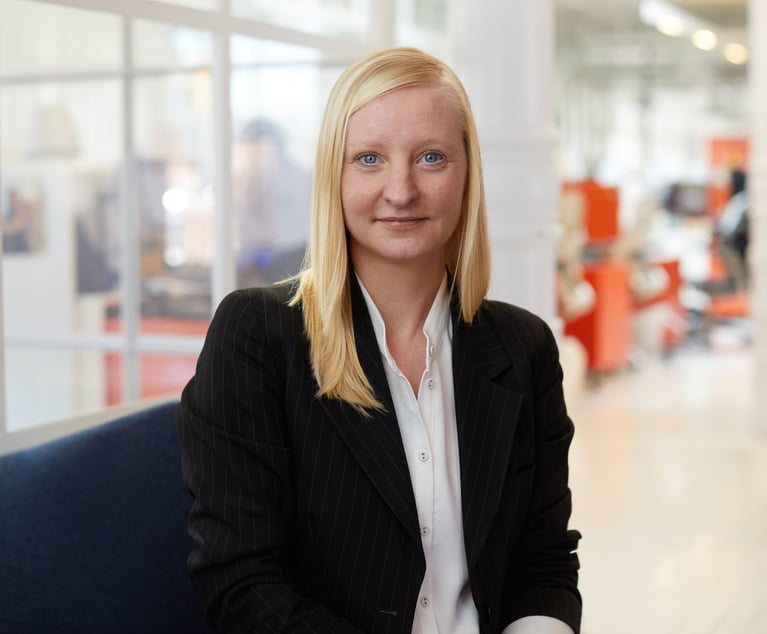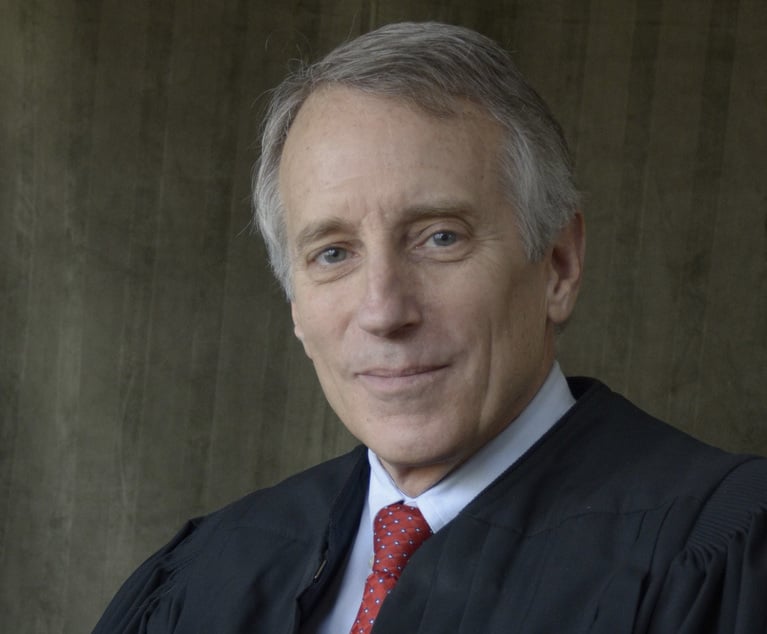Five Keys to Successfully Transitioning Clients Across Generations
Strengthening cultural expectations is key
February 04, 2019 at 03:12 PM
8 minute read
Client relationship succession planning is a top concern among law firm leaders. Citibank's 2019 Client Advisory devoted a section to this topic. Firms of all stripes frequently develop goals to in their strategic plans to facilitate more effective client relationship transitions. However, according to the results of an insightful survey by the Attorneys' Liability Assurance Society (ALAS) released to its member firms last year, there is room for many firms to take a more formal and proactive approach to effectively transition client relationships across generations.
This yields an increasingly important opportunity in the current competitive landscape in which many clients are using fewer and fewer firms over time. Over the past 10 years, legal departments have decreased rather than increased their spending on outside counsel. Many high-performing firms are successfully growing the size of their client relationships of strategic importance, increasingly serving them across the firm's platform. And consistent with that trend, 60 percent of GCs say they send nearly all of their work to their top 10 firms, according to a 2018 CounselLink survey.
In other words, many law firms are competing to attract and retain client relationships that are increasingly larger pieces of a shrinking overall pie of client spending on outside law firms. In addition, traditional client relationships face four growing competitive forces that are taking market share away from Am Law 200 law firms and creating impediments to transitioning client relationships:
- Firms outside the Am Law 200 are capturing an increasing percentage of market share over time – this trend may accelerate in an economic downturn;
- Alternative legal service providers are winning discovery, due diligence and other work that traditional went to large law firms;
- Technology is increasingly handling tasks traditionally performed by junior lawyers, with many firms investing in new approaches that will help them compete more efficiently in a rate-pressured market; and
- Big Four accounting firms are becoming a more significant competitive threat, particularly outside the US.
Many firms also struggle with internal factors that impede successful transitions. According to the ALAS survey, these include an “unwillingness to let go” on the part of relationship partners, a disconnect between compensation systems and effective client relationship transitions, fear of mortality, lack of appropriate successors, and communications challenges.
To combat these concerns, here are five drivers of successful client succession planning based on best practices of high-performing firms:
1. Link transitions to compensation
Most firms don't have the luxury of a rich pension plan to drive partner behavior. Instead, firms generally use carrots, sticks or a combination of both to drive effective transitions.
A commonly used carrot is linking successful transitions with compensation for partners who are nearing retirement. In this scenario, credit is given if the partner meets certain expectations for transition. Firms often give more than 100 percent credit for a relationship as an investment in successfully retaining and transitioning the client relationship across generations.
Some firms use a stick, lowering compensation for partners who fail to meet transition expectations. One high-performing New York firm steps down compensation of late-career partners on a five-year glide to retirement. The firm has certain expectations of partners during that period, including effective transition of their relationships to the next generation. To the extent a partner in the firm does not meet expectations during the glide to retirement, the steps get steeper so that compensation decreases more rapidly.
2. Incent teamwork
In her book, Smart Collaboration, Harvard Law School's Heidi Gardner presents data that indicates when lawyers collaborate across a firm's platform to serve clients, they generally produce larger, stickier and more profitable client relationships. Consistent with this concept, at McKinsey and many leading professional service firms outside of legal, the default is that teams, rather than individuals, serve clients. In recent years, an increasing number of law firms have begun to view hunting in packs and serving clients in teams as desirable approaches, and some firms consider the extent to which lawyers collaborate as a subjective driver in determining compensation.
For example, a high-performing Am Law 10 firm ranks partners by the extent to which they collaborate in pursuing and serving clients, and use this as a factor in setting compensation. Another high-performing firm, an Am Law 25 firm, tells young associates that when the time comes for them to be considered for promotion to partner, each associate will need to be backed by at least one partner outside of her or his practice area. This incents relationship-building across practices on an ongoing basis, which builds trust and paves the way for collaboration across practices. This in turn also allows for an institutionalized approach to serving and retaining clients, therefore creating an environment that breaks down silos and helps firms to retain clients over time, even as partners retire.
The benefit of teamwork across a firm's platform is clear: it allows ample time and opportunity for the next generation of leadership to gradually and naturally build close relationships with the firm's clients and with each other. This leads to natural transitions built on longer-term relationships of trust, which is far more effective than waiting until the eve of a retirement to try to facilitate a transition.
3. Pass the torch
One leading regional firm developed an initiative called “Project Torch” to provide a formal process for facilitating client relationship succession. Firm leaders meet individually with select partners nearing retirement to discuss their time horizons and put the transition process in motion. Individual transition plans of approximately three to five years are then developed for material clients, with leadership managing each relationship partner's progress against the plan.
At other firms with similar programs, partners are held accountable for transitioning clients by the managing partner or chair, their practice leaders, and/or the firm's compensation committee. According to the results of the ALAS survey, the transition process generally begins at least three years before retirement, with less than 10 percent of firms starting the process more than five years out, and just over 10 percent waiting until the last year before retirement. Our experience is that starting the process sooner rather than later, ideally five or more years in advance of retirement, often benefits the firm more than other approaches.
4. Consult the client
Firms with systemic, proactive client listening programs sometimes include questions to clients about the client's perception of the firm's bench-strength. Some firms also ask how the client would like their relationships to be transitioned across generations. For large and strategically important client relationships, some firms also formally solicit input from relevant partners and specific clients about attributes they believe will be required to successfully manage the relationship over time. To lead these conversations, some firms hire third-party, neutral consultants, while others tap formal or informal firm leaders in the firm.
Our experience is that these discussions can be valuable for firms because they provide an opportunity for clients to weigh in on and be part of the succession planning process. Sometimes warning signs surface. When asked, clients regularly express concern that they do not have visibility to the firm's succession plan for the relationship. In some cases, clients start expressing concern well before their relationship partner is near retirement age, in his or her 50s. Some clients who feel they don't have enough visibility to the firm's succession plans say that they go a step further and act on their concerns by quietly spreading work to other firms as a hedge against the possibility there is not an effective succession plan when the relationship partner retires.
5. Assist retired partners
A number of firms use an additional carrot to reward partners who meet expectations for retiring partners, including successfully transitioning their relationships. In addition to offering monetary benefits, some offer non-monetary incentives, such as providing administrative support during retirement, making introductions to nonprofit organizations and other opportunities, supporting a partner's chosen charitable causes, or keeping the partner close to the firm as a mentor or ambassador.
Using these and other strategies, many firms have an opportunity to increase their retention of client relationships across generations by creating a cultural expectation that clients are “firm clients” and will be retained over time for the long-term benefit of the firm and the client.

Kent Zimmermann is a principal with Zeughauser Group and an ALM Intelligence Fellow.
Kent is one of the legal industry's leading advisors on strategic planning and law firm combinations. As a former general counsel and chief executive officer, he counsels the leaders of Am Law 100, 200, Global 100, and leading specialty firms on the challenges and opportunities they face in an increasingly competitive market. He regularly interviews Fortune 500 and other global company GCs, managing directors and other business leaders. In 2018, he advised on each of the three largest law firm combinations in the United States.
More information on the ALM Intelligence Fellows Program can be found here
This content has been archived. It is available through our partners, LexisNexis® and Bloomberg Law.
To view this content, please continue to their sites.
Not a Lexis Subscriber?
Subscribe Now
Not a Bloomberg Law Subscriber?
Subscribe Now
NOT FOR REPRINT
© 2025 ALM Global, LLC, All Rights Reserved. Request academic re-use from www.copyright.com. All other uses, submit a request to [email protected]. For more information visit Asset & Logo Licensing.
You Might Like
View All
Avoiding the Great Gen AI Wrecking Ball: Ignore AI’s Transformative Power at Your Own Risk
6 minute read

'If the Job Is Better, You Get Better': Chief District Judge Discusses Overcoming Negative Perceptions During Q&A

'A Template' for Religious Accommodation: Attorney Gives Insight to $12M Win Over Employer's COVID-19 Vaccination Policies
Trending Stories
- 1We the People?
- 2New York-Based Skadden Team Joins White & Case Group in Mexico City for Citigroup Demerger
- 3No Two Wildfires Alike: Lawyers Take Different Legal Strategies in California
- 4Poop-Themed Dog Toy OK as Parody, but Still Tarnished Jack Daniel’s Brand, Court Says
- 5Meet the New President of NY's Association of Trial Court Jurists
Who Got The Work
J. Brugh Lower of Gibbons has entered an appearance for industrial equipment supplier Devco Corporation in a pending trademark infringement lawsuit. The suit, accusing the defendant of selling knock-off Graco products, was filed Dec. 18 in New Jersey District Court by Rivkin Radler on behalf of Graco Inc. and Graco Minnesota. The case, assigned to U.S. District Judge Zahid N. Quraishi, is 3:24-cv-11294, Graco Inc. et al v. Devco Corporation.
Who Got The Work
Rebecca Maller-Stein and Kent A. Yalowitz of Arnold & Porter Kaye Scholer have entered their appearances for Hanaco Venture Capital and its executives, Lior Prosor and David Frankel, in a pending securities lawsuit. The action, filed on Dec. 24 in New York Southern District Court by Zell, Aron & Co. on behalf of Goldeneye Advisors, accuses the defendants of negligently and fraudulently managing the plaintiff's $1 million investment. The case, assigned to U.S. District Judge Vernon S. Broderick, is 1:24-cv-09918, Goldeneye Advisors, LLC v. Hanaco Venture Capital, Ltd. et al.
Who Got The Work
Attorneys from A&O Shearman has stepped in as defense counsel for Toronto-Dominion Bank and other defendants in a pending securities class action. The suit, filed Dec. 11 in New York Southern District Court by Bleichmar Fonti & Auld, accuses the defendants of concealing the bank's 'pervasive' deficiencies in regards to its compliance with the Bank Secrecy Act and the quality of its anti-money laundering controls. The case, assigned to U.S. District Judge Arun Subramanian, is 1:24-cv-09445, Gonzalez v. The Toronto-Dominion Bank et al.
Who Got The Work
Crown Castle International, a Pennsylvania company providing shared communications infrastructure, has turned to Luke D. Wolf of Gordon Rees Scully Mansukhani to fend off a pending breach-of-contract lawsuit. The court action, filed Nov. 25 in Michigan Eastern District Court by Hooper Hathaway PC on behalf of The Town Residences LLC, accuses Crown Castle of failing to transfer approximately $30,000 in utility payments from T-Mobile in breach of a roof-top lease and assignment agreement. The case, assigned to U.S. District Judge Susan K. Declercq, is 2:24-cv-13131, The Town Residences LLC v. T-Mobile US, Inc. et al.
Who Got The Work
Wilfred P. Coronato and Daniel M. Schwartz of McCarter & English have stepped in as defense counsel to Electrolux Home Products Inc. in a pending product liability lawsuit. The court action, filed Nov. 26 in New York Eastern District Court by Poulos Lopiccolo PC and Nagel Rice LLP on behalf of David Stern, alleges that the defendant's refrigerators’ drawers and shelving repeatedly break and fall apart within months after purchase. The case, assigned to U.S. District Judge Joan M. Azrack, is 2:24-cv-08204, Stern v. Electrolux Home Products, Inc.
Featured Firms
Law Offices of Gary Martin Hays & Associates, P.C.
(470) 294-1674
Law Offices of Mark E. Salomone
(857) 444-6468
Smith & Hassler
(713) 739-1250








